Motorway harbour’s biggest threat since deforestation
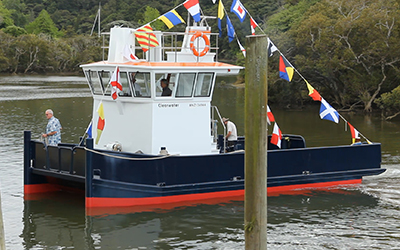
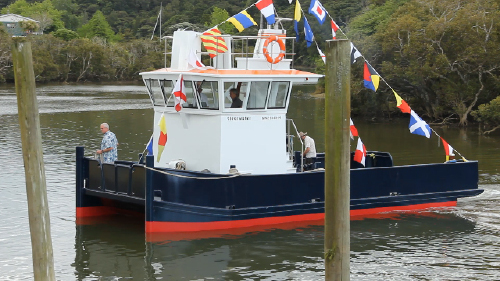
Clear Water Within Reach: When its matching barge is launched, the purpose-built tug Clearwater will be capable of shifting 120 tonnes of sediment on a single tide, and thus the long task of restoring the reasonable navigability of the Mahurangi River can be commenced. But if just 1% of the soil the New Zealand Transport Agency proposes to move to create a Pūhoi–Warkworth motorway finds its way into the Mahurangi River, it would represent one barge load per day, five days a week for the five-year period of construction. image Majorlook Productions
Clearly, something has to be done. State Highway 1 between Pūhoi and Wellsford is lethal, and at times congested.
In 2010, the Campaign for Better Transport in its Operation Lifesaver document came up with two options, either of which, by now, could be having a huge positive impact on the road’s infamous death toll: 41, between 2000 and 2009.
But in bloody-minded adherence to the outmoded free-enterprise road-transport option, the straightforward, affordable safety measures could, by now, mostly have been implemented, with the saving of a potential 50 lives by the projected time the proposed motorway addressed the notorious Dome Valley section of the highway.
Not included in Operation Lifesaver, but well known to locals, is how one fatal intersection could be easily remedied, to improve multiple outcomes. In 1982, when the current highway bridge immediately to the south of the intersection with Mahurangi West Road was built, locals anticipated a safer means for northbound vehicles to turn off the highway. But they were to be disappointed, when no turning lane materialised—they were told that the intersection was closer to the bridge than guidelines allowed, for a turning lane to be safely included. Years later, at an onsite meeting instigated by a wealthy and influential local, a Rodney District Council engineer had the solution: Reroute the last 150 metres of Mahurangi West Road to the north of the telephone exchange building, to increase the distance from the highway bridge, and to improve sightlines for cars pulling onto the highway, both north- and south-bound. In the event, the then Transit New Zealand relented on its bridge-to-turning-lane-distance rule, and created one. Although this was a distinct improvement, a golden opportunity to achieve an even less hazardous intersection was forsaken, likewise lost was the opportunity provide park-and-ride parking, using the remnant of Mahurangi West Road. And while locals have long parked and riden, the riding has been in the form of car-pooling. With the simple addition of bus bays, public transport begins to become possible.
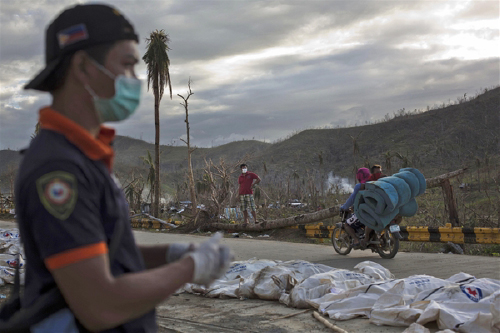
Warming Body Count: Warmer seas equal more violent storms and higher storm surges. Projections for likely sea-level rise by 2100 rise constantly as scientists gather more data and discover more about the dynamics of ice sheet melt. A number now are projecting a sea-level rise of more than two metres this century. This may yet prove to be wildly conservative, and of course, rather than that be the extent of it, sea-level rise will only just be starting, given the probability of a total loss of the planet’s ice sheets. photographer David Guttenfelder
Such examples are likely not what the yet-to-announced board of inquiry will want to hear about during the next nine months as the Pūhoi–Warkworth motorway is put through the Environmental Protection Authority fast-track process. Nor will the board want to hear about the existential environmental issue, global warming. With the death count from Typhoon Haiyan at more than 5200 in the Philippines, which was hardest hit, and with more than 23 000 injured, Philippines economic planning secretary Arsenio Balisacan estimates the cost of rebuilding to be nearly US$6 billion. Small wonder world leaders, such as David Cameron, are finally feeling brave enough to publicly join the dots between increasingly severe weather events and warmer climate. The combination of greater storms, greater storm surges and higher sea levels is a recipe for disaster in low-lying cities, rich and poor.
The government is desperate to make the Pūhoi–Wellsford motorway a fait accompli before next year’s election, with the project being notified by the Environmental Protection Authority smack in the middle of the silly season. The project, according to the New Zealand Transport Agency executive summary issued concurrently, is primarily to address ‘limited network resilience’. Yet Auckland’s existing key roading network is at extreme risk, as was illustrated by the 23 January 2011 storm surge that inundated the southbound lanes of the Northern Motorway. A five-metre storm surge would sever transport to the North Shore and Northland.
Motorways, or rather road transport in its entirety, are the single greatest contributor to global warming. Power, industry and biomass-burning each produce more greenhouse gases than does road transport, but they simultaneously emit more agents that have cooling effects. But despite the climate change impact of road transport, the New Zealand Transport Agency, in its executive summary of the proposal, only looks at road-based alternatives, and then only considers different routes. Alternatives, such as smarter use of the existing road, for example a civilised bus service for commuters between Warkworth and the city, are totally ignored.
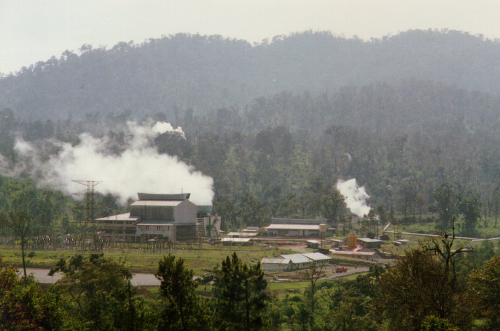
$2 Billion to Burn: If the government really does have a spare $2 billion, rather than a fossil-fueled motorway, it should seriously consider investing that money in new, state-of-the-art geothermal power production, to retire Huntly and allow Aotearoa to boast 100% renewable electricity. With no new power generation planned in the next five years, the industry is in a flat spot, right at the time Aotearoa is co-hosting the World Geothermal Congress by New Zealand with Australia, in 2015—Australia stumped up the $250 000 cost of the bid. Meantime, the Indonesian government (Kamojang geothermal power station pictured) is looking to invest $15 billion in geothermal… photographer David Guttenfelder
The New Zealand Transport Agency undoubtedly believes it can safely ignore global warming in its impact reporting, because, bizarrely, the Resource Management Act effectively excludes considerations such as a project’s greenhouse gas impact. At least that was the ruling of a Supreme Court majority decision in September. Dissenting from that decision was Chief Justice Dame Sian Elias, who stated that the 2004 amendment to the act was:
limited to local authority regulation of and consents to the discharges of greenhouse gases into the atmosphere.
Within a year of being elected in 2008, the National Party, with the collusion of the Māori and United Future parties, established the Environmental Protection Authority. The purpose behind its beguiling name is all too evident from the name of the empowering legislation: The Resource Management (Simplifying and Streamlining) Amendment Act 2009. The board chairman is Kerry Prendergast, a onetime National Party list candidate and Wellington mayor, with a nursing, as opposed to environmental, background.
With the motorway proposal safely out of the hands of the local authority, Auckland Council, it has been placed farther at arms length, in the arms of a yet-to-be-named board of enquiry. Further, it starts the clock running on an enquiry with a time-bound, nine-month, timeframe.
Given that even by pursuing the impact of a proposal on global warming all the way to the Supreme Court is unlikely to see the issue heeded, many submitters otherwise strongly exercised about unabated greenhouse gas emissions will probably chose to keep mum on the subject. This is unfortunate, because sooner or later legislation will require greenhouse gas emissions to be taken into account—it is unconscionable that the mother of all environmental impacts remains beyond the reach of the law. ‘EPA’, in the United States, stands for Environmental Protection Agency. Although fossil fuel interests are throwing everything at it, the agency is now beginning to regulate greenhouse gas emissions, under President Lyndon B Johnson’s Clean Air Act, thanks to the determination of President Barack Obama.
Meantime, the effect of global warming on the proposed motorway project that could impact profoundly on the Mahurangi Harbour. The executive summary states:
Potentially, there is an effect on marine ecology of moderate value within the Mahurangi Harbour due to sedimentation arising from a large, low probability (50 year ARI) rainfall event during peak open earthworks.
Fifty-year average recurrence interval events are occurring far more frequently, and will occur with increasing frequency, thanks to the global warming already locked in, and to that which is inevitable unless radical climate action is undertaken. And then there are the 100-year average recurrence interval events. While it will be argued that the probability of extreme rainfall events coinciding with peak open earthworks might be miniscule, the impact on the harbour could be catastrophic. Besides, to be ruinous, an extreme rainfall event would not have to hit during the peak open earthworks period.
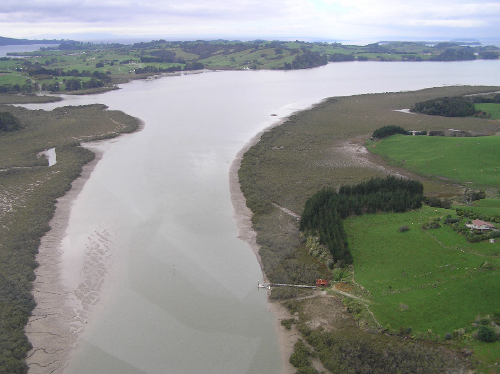
Mahurangi Looks After its Own: Where the Pūhoi River displays a spectacular ability to discharge a highly visible muddy plume into the Hauraki Gulf, following heavy rainfall, the Mahurangi mostly intercepts and its sediment within the confines of the harbour, to the benefit of the mangroves, and the great detriment of its benthic communities. image Auckland Council
But while it is unsurprising that it ignores global warming, what is astonishing is that the executive summary doesn’t once mention the Mahurangi Action Plan or the two decades of science underpinning it, indicating that the harbour’s stressed benthic communities are already staggering under an elevated sediment accumulation rate. All the good work done since 2004, when the Auckland Regional Council kick-started a five-year, $3 million programme of riparian protection, could be undone literally overnight should an ex-tropical cyclone land a direct blow during the five or so summers of motorway earthworks.
The proposed earthworks would impact on two catchments. If an extreme rainfall event were to wash tens of thousands of tonnes of sediment into the Pūhoi River, most of the mud would eventually be flushed into the Hauraki Gulf. Not pretty, but probably not terminal for the Pūhoi. For the Mahurangi Harbour however, the outcome could be very different. On average, the equivalent of 30, 29-tonne truck-and-trailer loads per week of sediment washes into the harbour—a staggering nearly 46 000 tonnes per year (averaged over a 26-year period). This amount or more can, and does already, wash into the harbour in a single event.
If an extreme rainfall event struck during the peak period the proposed eight million cubic metres of earth and rock were being worked, the Mahurangi Harbour may never fully recover. Unlike the Pūhoi, the Mahurangi looks after its own—the vast proportion of sediment that is washed into it, remains in it. The ratio of tidal prism to river flow is such that the latter is ineffectual at flushing the solid matter out into the gulf—rather like a public toilet with only the water-conserving mode of its dual-flush cistern operational.
Few would argue that State Highway 1 between Pūhoi and Wellsford is adequate for current traffic volumes, particularly at peak holiday periods. In the 1950s, Warkworth found it necessary to build a bypass to the west the town—prior to that time, the main street was the main highway. But even with the bypass, the highway detoured considerably from its logical route, in order to pass close by the town. The need for a new bypass, further reducing the dogleg, has been blindingly obvious for decades, as has the need for a new section of road to link it to Matakana Road, thus relieving the vexing seven-way Hill Street intersection of the bulk of its traffic.
A fully costed alternative to the National-led government’s Pūhoi–Wellsford motorway, Operation Lifesaver, was produced by the Campaign for Better Transport during the public consultation phase in 2010. For about a fifth the cost, and in about a fifth of the time, the highway not just to Warkworth, but all the way to Wellsford, could be relieved of its congestion points, and be rendered considerably safer. Besides, the route between Warkworth and Wellsford is so challenging that a completion date is ‘Not yet determined’, meaning that the Dome Valley will continue to take lives that the pragmatic measures contained in Operation Lifesaver could already be sparing.
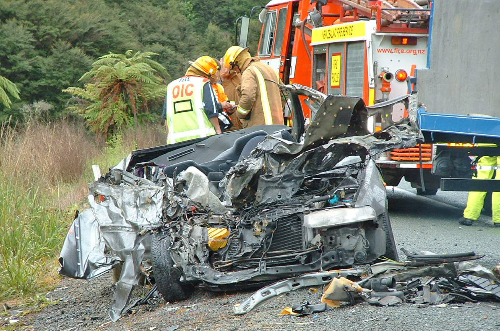
Not Yet Determined: Despite the Dome Valley’s lethal record, the New Zealand Transport Agency status of any major remedy is ‘Not yet determined’. For about the cost of the planning for the Pūhoi–Warkworth motorway, Operation Lifesaver could already have largely stopped the carnage. photographer Richard Marsh
Proponents of the proposal have consistently cited benefit to Northland’s economy, as a road of national significance. Northlanders, however, would much prefer to see the up to $2 billion spent in Northland. An obvious first step is the rail link to Northport. But the most critical link needed is in Auckland. While Auckland’s mayor was so fixated on a proposed rail loop known officially as the City Rail Link that he was prepared to go along with the proposed Pūhoi–Wellsford motorway, he has been blind to the bleeding obvious: A rail-and-public-transport-only second Waitematā Harbour crossing. The road-transport-only Auckland Harbour Bridge was conceived when the automobile was in the ascendancy, as part of the 1955 Master Transportation Plan. The city has been paying since, with the North Shore only getting civilised transport with the opening of the Northern Busway, which became fully operational in 2009.
Public transport works best where it enjoys a natural monopoly on a given route. A harbour bridge that was not clogged with private cars would whisk commuters in and out of the city economically, and in a fraction of the time it takes by car in the rush hours. And because of its elongated geography, a part new, part upgraded Northland railway would similarly enjoy a natural monopoly, given the, in places tortuous, road alternative. Holidaying in the Far North would be a delight by rail, and developed as a rail with trail corridor, would do wonders for the region’s tourism.
As mentioned earlier, the board of inquiry will not be much interested in hearing submissions that are not immediately about the project. So while the greenhouse gas emissions impact of the proposal is the existential issue, sediment generation is the aspect the board is compelled to take seriously into consideration. To that end, Mahurangi Action will lodge a submission and apply for funding from the Ministry for the Environment to have the assessment of environmental effects peer reviewed by the world-class consultancy DHI Group.
With an already elevated sediment accumulation rate, the risk to the Mahurangi Harbour, while eight million cubic metres of earth and rock are proposed to be shifted, is worthy of extremely circumspect assessment. If just half a percent of that material escaped the proposed attenuation measures, with 0.3% ending up in the Mahurangi Harbour in one year, the average already elevated annual sediment load would be doubled. And yes, that is nearly 1600 29-tonne truck-and-trailer loads.
The Mahurangi Harbour is facing its biggest threat since deforestation.
Footnote Saved by the Mangroves? A Philippine Town Dodges Haiyan’s Storm Surge
Update Typhoon Haiyan: Death Toll Tops 6000 in Philippines; Nearly 1800 People Still Missing
